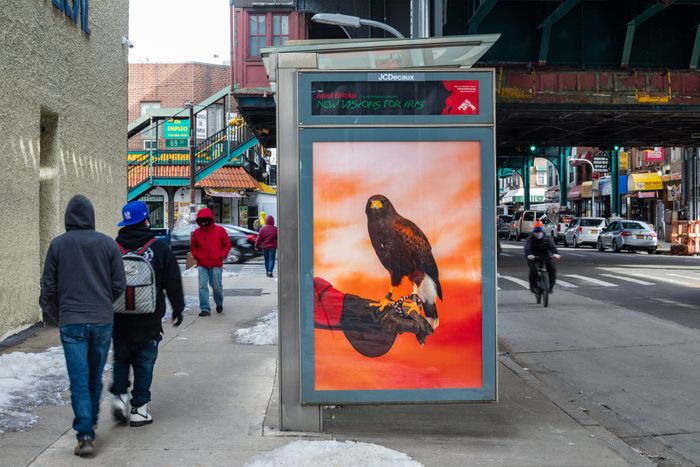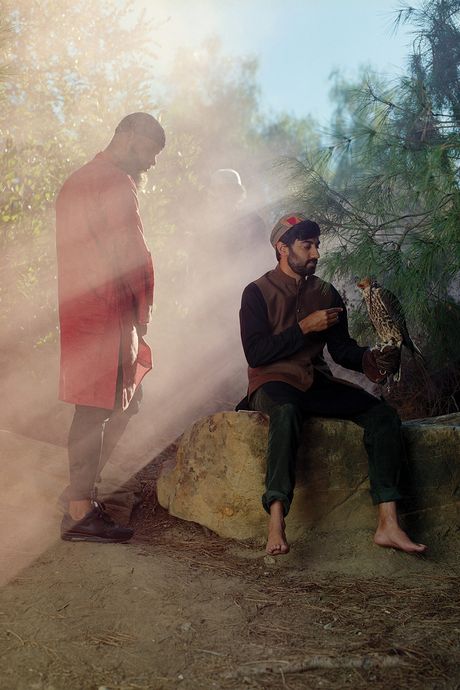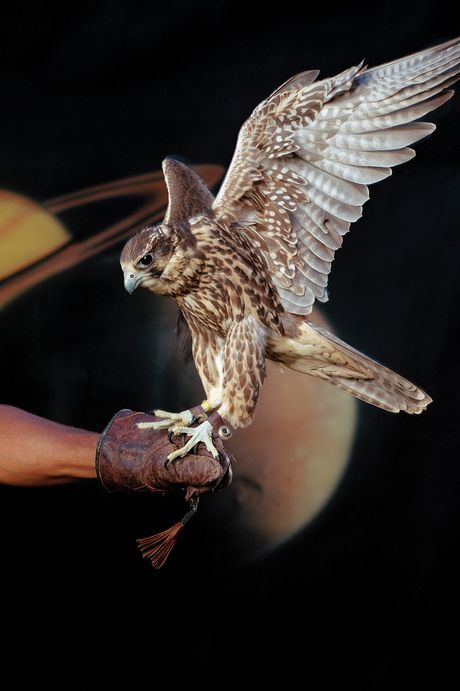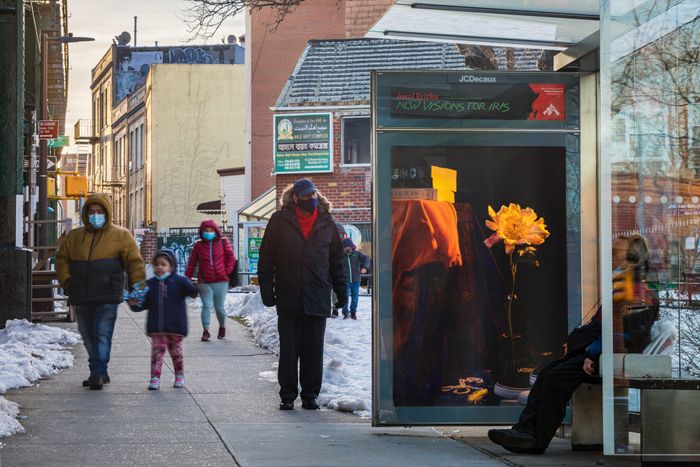
If you pass by a bus shelter between now and June 20, take a closer look at it. You might spy the image of a Muslim man in a Kobe jersey kneeling in prayer next to a motorcycle, or a still life with a toy cart, irises, a light meter, and magnetic letters from the Amharic alphabet. These photographs are part of “New Visions for Iris,” the first public art exhibition by the Los Angeles–based, Ethiopian American artist Awol Erizku. Commissioned by Public Art Fund, the exhibition appears on over 200 bus shelters across New York City (and over 150 in Chicago). Erizku dedicated it to his 1-year-old daughter, Iris.
“[Iris’s] influence on this work is possibility,” Erizku says. “She’s American, she’s Ethiopian, and because I wasn’t able to see these kinds of images growing up, I wanted to make sure she did.” The kind of images he’s referring to include modern representations of Muslim men, African symbols, and his own personal history. “To be honest, I am ashamed I don’t know as much about my culture as I would like, and I wanted to give her these [references] early on.”
The references are also entry points to conversations about religion, spirituality, race, identity, and personal history — conversations that many of us are having since the Black Lives Matter protests, the increase in hate crimes against Asian Americans, and the general upheaval the city has experienced in the past year.
“This exhibition is about coming to terms with fatherhood and having a daughter that’s come into this world in a very tumultuous year, and finding ways to elicit certain conversations as she’s growing up,” Erizku says.
Erizku first became famous for work that subverted European masterpieces with Afrocentric references, like his 2009 Girl With a Bamboo Earring portrait, which riffs on Vermeer’s Girl With a Pearl Earring painting, and his 2013 portrait series of sex workers in Addis Ababa posed in the manner of Ingres’s odalisques and Manet’s Olympia. His 2015 short film “Serendipity,” which screened at MoMA, featured him smashing a bust of David and replacing it with one of Nefertiti. But lately, he’s felt strongly about moving away from the Western philosophies and references he’s been indoctrinated with and creating his own canon. In 2017, his anti-Trump “Make America Great Again” exhibition explored the power of Emory Douglas’s Black Panther logo. This has led him to develop a new visual language he’s calling “Afro-esotericism” — an index of objects, symbols, and people that are meaningful and influential to him: Cowrie shells, African masks and statues, musical instruments, the Qur’an, flowers, and more. This reinvention is also partly a response to how popular his older work has become. His style has been copied time and time again, to the point where he feels like he’s lost ownership of it and it’s no longer associated with him.
Now Erizku’s photographs appropriate the dramatic lighting and saturated colors of commercial advertising, which is designed to stop you in your tracks. He uses it as a kind of bait and switch. Instead of selling you sneakers, he’s inviting you into his cultural universe.
He walked us through a few of the images in the series.
“The thread of Islam-slash-spirituality that is ubiquitous in my work is especially present in this body of work. For this exhibition, I originally wanted to document prisons and show where men congregate to pray and find room for spirituality and religion in those spaces — that even in a physical prison you could still find freedom from within. That was the big idea I wanted to explore. We did a lot of interviews with chaplains and Imams and right when we were ready to go in and make these images, we were told everything was shut down and we didn’t have any access. Even though the project needed to evolve in some ways, the spirit of what I wanted to do is embedded in the images into a more metaphorical way of thinking.”
“I’ve been thinking a lot about the ethical way to memorialize someone. Kobe passed away around the same time my daughter was born. I remember how gloomy it was that day and talking to my sister about how it felt like losing a family member. The last time I went to pray before lockdown, the person in front of me was wearing a Kobe jersey. This made sense as a sort of memorializing for Kobe.”
“These magnetic Amharic alphabet tiles are Iris’s. I bought them for her when she was still in the womb because I knew she would learn from them at some point. My mother sent a poem [in Amharic] to Iris and I tried to translate it, but I couldn’t capture the essence. I thought: I am just going to leave this poem as is so she can learn the language and decipher it herself.”


Commissioned by Public Art Fund for Awol Erizku: New Visions for Iris, an exhibition on 350 JCDecaux bus shelter displays across New York City and Chicago, February 24 to June 20, 2021 Courtesy of Awol Erizku.
Commissioned by Public Art Fund for Awol Erizku: New Visions for Iris, an exhibition on 3... Awol Erizku, Revelations (left) and Going Home (right), 2020.
Commissioned by Public Art Fund for Awol Erizku: New Visions for Iris, an exhibition on 350 JCDecaux bus shelter displays across New York City and Chicago, February 24 to June 20, 2021 Courtesy of Awol Erizku.
“The falcon is a symbol and gesture toward freedom. It’s more about the Black man as a master of his domain. [In some images] the bird is just hanging out, no strings attached. He’s just there.”
“I was commissioned by GQ to document a series that, for lack of a better phrase, is on the fathers of the men who we see in the news: George Floyd, Michael Brown, Terence Crutcher — men who were in high-profile police shootings in the past few years. To me, it’s astonishing that we live in a society where [police killings] are normalized. That’s the hard part. Taking on this project was about portraying these men in a light that we don’t see them in the news. Everyone was in such different places in the grieving process. As a new father myself, I’ve really been trying to wrap my head around what they must have been going through.”
“New Visions for Iris” is on view until June 20, 2021. While the exhibition is across all five boroughs, there are heavier concentrations of the images on 125th Street in Harlem, and near 161st and Grand Concourse in the Bronx — areas that are personally important to Erizku, who was raised in the Bronx.










